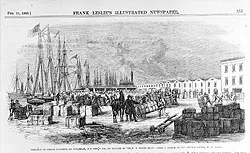When the southern states seceded from the Union in 1861, major government institutions suffered divided loyalties. The Confederacy set up its own version of the Treasury Department's Customs Service, mirroring the responsibilities of its federal counterpart. For both North and South, customs was crucial; international trade brought not only much-needed supplies, but also money through customs collection of duties, fees and penalties on the imported goods.

and captured key coastal cities, it reopened
blockaded ports for trade with northern
states as well as foreign nations. Photo
Credit: Library of Congress
Through congressional acts after the war began, President Abraham Lincoln moved quickly to protect federal customs rights, responsibilities, and ports of entry served. Employees had to take an Oath of Allegiance to "support, protect, and defend the Constitution and government of the United States against all enemies, whether domestic or foreign" or face dismissal. Many U.S. Customs employees who declined to affirm their loyalty continued in their jobs-but for the Confederate Treasury.
Some of the early acts of the Congress of the Confederate States of America approved the appointments and salaries of the customs collectors, and designated funds for the customhouses at New Orleans and Charleston. In the north, Union customs collectors received the authority to set up offices wherever feasible. If functional space at the port of entry was unavailable, then any place where goods were delivered was acceptable. At their discretion, they could establish a customhouse aboard a ship at sea.
New Union regulations governed trade with the "disloyal States" as well as with foreign powers. The collector of customs seized vessels thought to belong in whole or in part to supporters of the secessionists or believed to be carrying goods or supplies intended for the "insurrection"-some very obvious like munitions and others less so. Northern collectors paid particular attention to cotton-the king of southern commodities, sought after in the north as well as overseas, and highly profitable for the Confederacy through supply of English textile mills.
Lincoln initiated a federal blockade of southern sea ports to prevent transport of illicit cargo. Of the Union ships patrolling the coastal and inland waterways, customs directly oversaw revenue cutters that captured or destroyed many blockade runners. However, shippers unwilling to risk losing their vessels, cargos and crews in races with the cutters developed ways to skirt the blockade. Exporters might declare that their goods were bound for a Union-friendly destination, when in fact their final port was in the Confederacy. The border with Mexico also provided a route to send out cotton and tobacco and bring in other supplies.
At the conclusion of the war, President Andrew Johnson made clear his intent to swiftly reunite the states under one government. In a communication to the House and Senate on Dec. 5, 1865, he noted: "The blockade has been removed and the custom-houses re-established in ports of entry, so that the revenue of the United States may be collected," and "the opening of the ports invite the restoration of industry and commerce." Customhouses were repaired or rebuilt, and customs employees-former Union and Confederate alike-went back to work in service to the nation.

